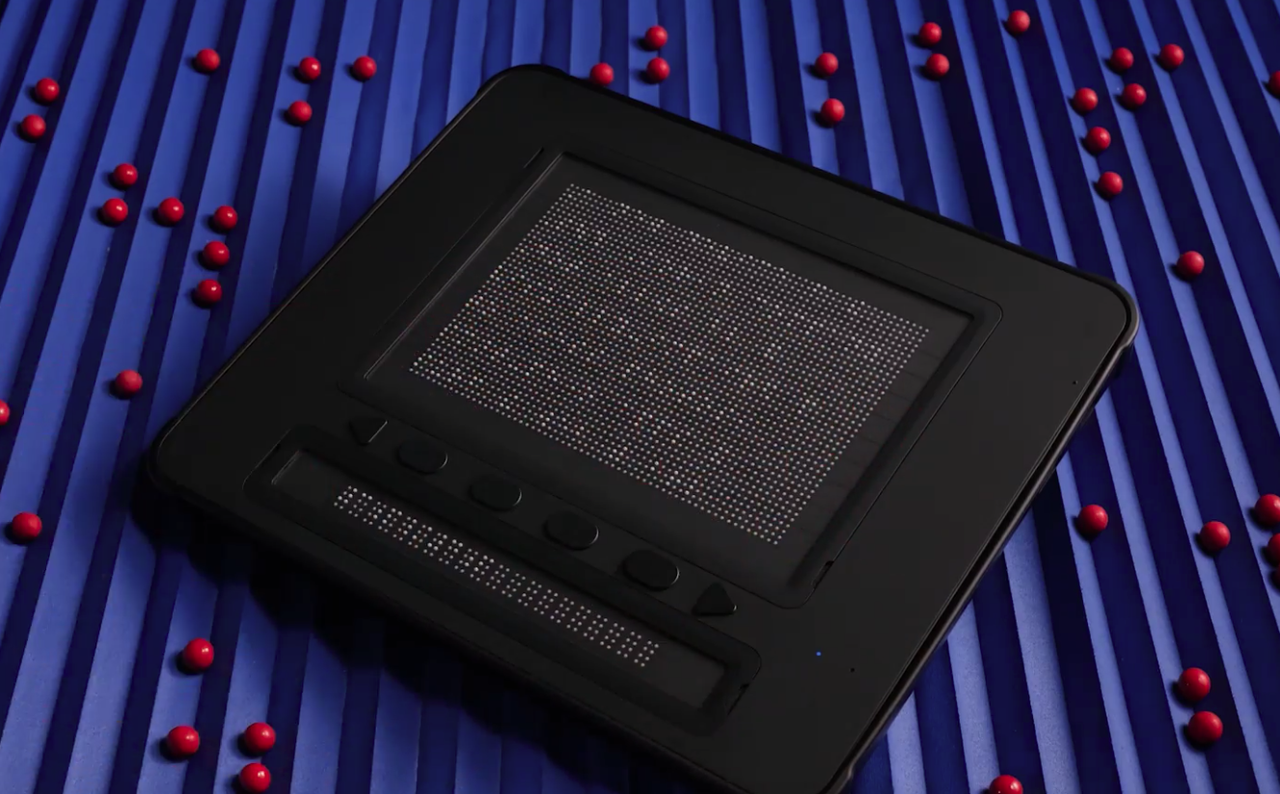PR/IR
News
News
News
- Date
- 2024.10.23 11:00
Many blind people miss out on how the rest of the world uses smartphones and other electronics for reading, movies and perusing the internet. Breakthroughs in technologies that use touch could change that.
A wave of new digital devices is emerging to access information digitally and display raised Braille text and tactile graphics, refreshing in real time. Researchers are pursuing ways to eventually even show moving images and live sports that can be followed by touch.
“We’re hoping that this will be almost a revolution,” says Karen Anderson, education programs coordinator at the National Federation of the Blind, who herself is blind.
Innovation has been slow for decades, hampered by lack of investment. Braille, the reading and writing system with characters made of raised dots, was developed in the 1800s. Digital Braille equipment has been clunky, expensive and limited in capability.
Among the new technologies, South Korea-based Dot created an electromagnetic system that allows thousands of tiny pins to move up and down on the surface of a digital pad as part of a refreshable Braille display. NewHaptics, a company founded by University of Michigan researchers, is working on a device with a different technology that uses air pressure to move dots on a display.
Other researchers are testing whether artificial intelligence can be used to more quickly translate books into Braille—an arduous process that can now cost more than $50,000 for a textbook—and convert images to tactile forms.
Some hope the new tactile devices will help level the playing field for visually impaired students, who typically learn using Braille or audio tools. Children who can see are exposed to many pictures by the time they begin preschool, and that also helps with spatial understanding. Math and physics, because of their symbols and equations, are easier to teach and learn through Braille than audio devices. Dependence on audio can also hurt spelling, as it’s difficult to distinguish when words sound the same but are spelled differently, for instance.


“Listening is not literacy,” says Anne Lancaster, chief officer of innovation and strategy at American Printing House for the Blind, a nonprofit founded in 1858 that helps visually impaired people and students access books, classroom materials and technologies. “You’re creating a complete alternate reality from the rest of the world.”
In the U.S., more than seven million people have impaired vision, including one million who are blind, according to the Centers for Disease Control and Prevention. About half of the adult blind U.S. population isn’t employed, according to researchers at Cornell University’s Yang Tan Institute on Employment and Disability—a statistic some experts say stems largely from lack of Braille access and proficiency.
Only about 10,000 Braille devices are sold annually around the world, with many of the purchases made with government funds, according to the American Printing House for the Blind.
The 1950s Perkins Brailler, a typewriter-like device that creates raised Braille characters on paper, remains widely used and costs more than $800. Most of the electronic devices developed up to now have used “piezoelectric” technology, which generates electricity using pressure to move small raised pins to create Braille dots that refresh, rather than embossing on paper. With this technology, it’s difficult to build a multiline Braille display and they usually show a single line, which means only up to 40 characters at a time can be read.
Ki Kwang Sung and Eric Ju Yoon Kim, childhood friends in South Korea, founded Dot in 2015. Seeing pictures of a Braille Bible that—due to the size of the characters—had multiple volumes and weighed more than 90 pounds helped inspire the effort to create an affordable and convenient device for the blind, Kim says. Widening access to Braille is a major goal, he says. “We thought that if we create a tactile screen that meets a global standard, that might open the door for education, jobs, entertainment, rehabilitation.”
In 2016 Dot introduced a tactile smartwatch called the Dot Watch, which used magnets and electromagnetic technology to enable four refreshable Braille cells, or characters, to show the time. Building on that technology, they assembled a team of engineers and collaborated with the Korea Advanced Institute of Science and Technology to create their latest device, the Dot Pad.
Roughly the size of an iPad, it shows 320 Braille cells, which can display text as well as graphics and images. The underlying technology uses 2,400 pins that respond to more than 5,000 control lines that are run by an electronic microcontroller. Users can access content from connected computers and smartphones and display it in Braille, updating in real time. Dot Pad is compatible with Apple devices and works with Apple’s VoiceOver.
Dot hopes its technology will lead to displays of moving images, animation and live sports, in part by improving the dots on displays to move faster and at different heights, providing a more complex picture to users. It is also working on improving the resolution of tactile images.
 The Monarch, a stand-alone device that uses Dot’s technology, was released in September. Photo: Humanware
The Monarch, a stand-alone device that uses Dot’s technology, was released in September. Photo: HumanwareAmerican Printing House for the Blind, working with Humanware, a subsidiary of eye-care company EssilorLuxottica, used Dot’s technology to help create a device the size of a laptop called the Monarch, released in September. The Monarch’s display shows 10 lines of Braille, aimed to make it easier for students to read textbooks.
Unlike the Dot Pad, it is a stand-alone device that doesn’t need to be connected to another computer. It includes a Braille keyboard, and its word processor allows formatting, such as headers and paragraphs, which hasn’t been available previously. Graphics and text can display concurrently, and touch-screen capabilities enable zooming in. Users can also play chess.
These devices remain costly. Some distributors in the U.S. list the Dot Pad for more than $12,000. Kim says the company uses affordable materials and that the device should eventually be available at about the same cost as a laptop as volume and distribution increase. The Monarch retails for $17,900, and, with government subsidies, drops to $14,900. Federal funds helped purchase many of the 400 Monarch devices that U.S. schools have ordered.
In the U.S., Dot is pushing to sell its device to corporate employers. Internationally, it is being used by some universities for research purposes. Schools for the blind, in South Korea and other countries, are supplying it to their students.
The Dot Pad recently won registration from the U.S. Food and Drug Administration as a medical device, which could lead it to be used in facilities serving the blind. Dot plans to start a clinical trial next year to see whether the device can improve a blind person’s sensorimotor learning, which, if successful, it says could potentially lead to insurance coverage.
Write to Jared S. Hopkins at jared.hopkins@wsj.com


 Prev
Prev
 Next
Next









